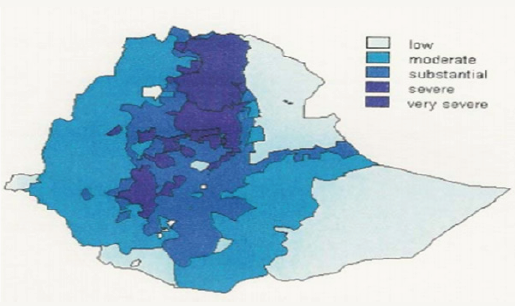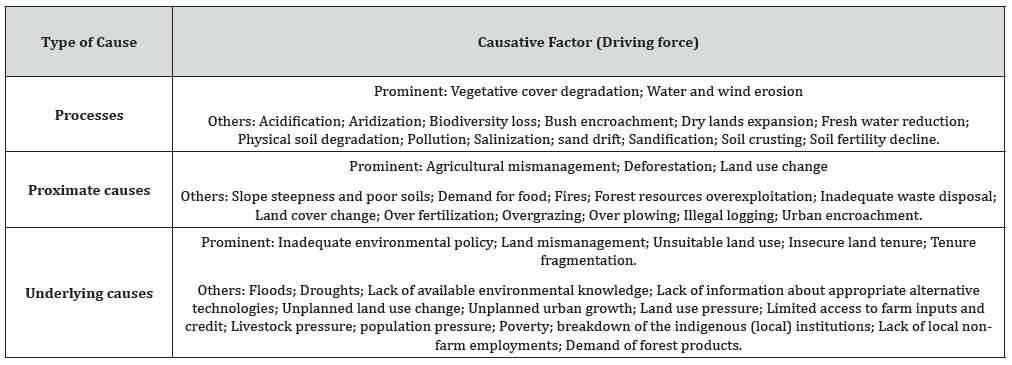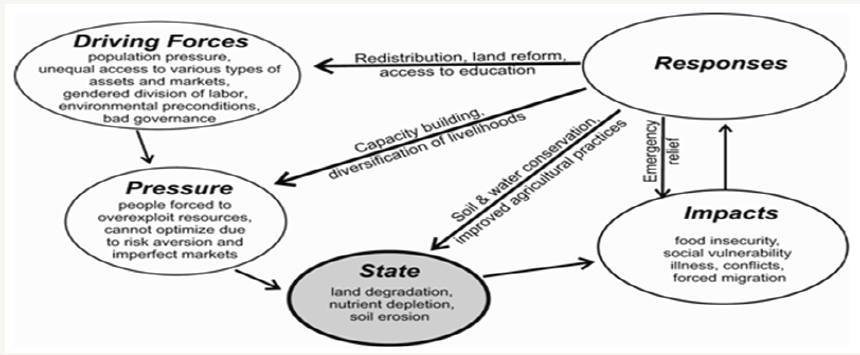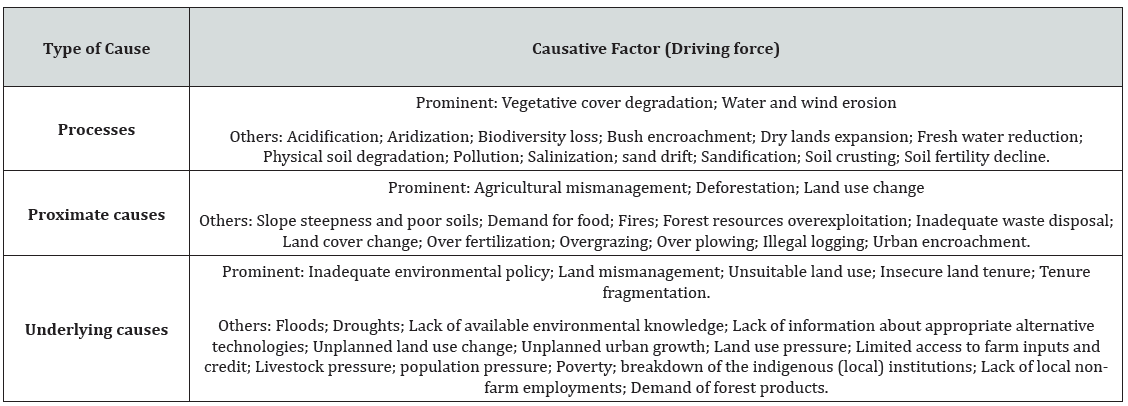- Submissions

Full Text
Approaches in Poultry, Dairy & Veterinary Sciences
Application of DPSIR Framework for Assessment of Land Degradation: A Review
Weldemariam Seifu Gessesew*
Department of Horticulture, Salale University, Ethiopia
*Corresponding author: Weldemariam Seifu Gessesew, Department of Horticulture, College of Agriculture and Natural Resources, Salale University, P O Box: 245, Fiche, Ethiopia
Submission: August 29, 2017; Published: November 13, 2017

ISSN : 2576-9162Volume1 Issue5
Abstract
The main objective of this review paper is to give an overview on the causes and impact of land degradation in Ethiopia through the DPSIR scheme for land degradation assessment. Land degradation is a process of the reduction of land resources production potential and is the deterioration in quality of the environment for humans, vegetations, animals and aquatic life. It is a complex phenomenon triggered by the interplay of environmental, social, economical factors. It happens all over the world but its severity is more in parts of Africa particularly in sub-Saharan Countries. The problem of land degradation in rural areas is highly interlinked to food security and quality of environment. Despite the nonstop ongoing degradation, land users and policy makers have responded in many instances with innovative practices and policies to protect degraded lands and degradation process at all. DPSIR approach is among the appropriate environmental assessment tools contributing in the formulation of environmental policies. It is a significant model and simplifies the monitoring system of land degradation.
Keywords: Land; Degradation; DPSIR; Ethiopia
Abbreviations: EHRS: Ethiopian Highland Reclamation Study; CCD: Combat Desertification
Introduction
Land degradation processes, which imply a reduction of the potential of productivity of the land (soil degradation and accelerated erosion, reduction of the quantity and diversity of natural vegetation) are widely spread and are defined as the long term loss of ecosystem function and productivity caused by disturbances from which the land cannot recover unaided. It refers to deterioration in the quality of the environment for humans, vegetations, animals and aquatic life and degradation has no single readily-identifiable feature but instead describes how one or more of the land resources (soil, water, vegetation, rocks, air, climate, and relief) has changed for the worse [1,2]. Land degradation is a complex phenomenon triggered by the interplay of environmental, economic and social factors and is reaching a significant dimension especially in rural areas of developing countries where its effects are more severe [1,3-7].
Land degradation includes all process that diminishes the capacity of land resources to perform essential functions and services in ecosystems which are caused by two interlocking complex systems: the natural ecosystem and the human social system and the interactions between the two systems determine the success or failure of resource management [8]. Land degradation which is also seen as a decline inland quality caused by human activities, has been a major global issue since the 20th century and it has remained high on the international agenda in the 21st century. In the last decades, humans have more than ever been changing the world's ecosystems to meet the growing demands for food, freshwater, timber, fiber, fuel and minerals [9].
Figure 1: Illustrates the regional extent and intensity of soil degradation, adapted from, Hakkeling [10].

Land degradation happens all over the world, but is a particular problem in parts of Africa and Ethiopia. The importance of land degradation in Ethiopia is enhanced because of its impact on food security and quality of the environments. Its consequences can be devastating for people and wildlife and closely linked with other environmental and social problems such as climate change and poverty and its remedy is tied up with them. An assessment of the status of land degradation in Ethiopia was done 20 years back. Although it is believed that land degradation has continued with equal or greater intensity, there has never been a systematic and comprehensive assessment since then. Therefore according to the Ethiopian Highland Reclamation Study (areas above 1500m), sheet and rill erosion and the interrelated physical degradation process are the dominant degradation processes on land degradation (Figure 1) and the annual soil erosion rate was estimated to be 1.5 billion tons (Table 1) [10,11].
From all land use and cover types, the severity is worst on cropland, where the annual soil loss rate is in a range of 42 tons ha-1 yr-1. The Ethiopian Highland Reclamation Study (EHRS) estimated that the annual soil erosion rate on the highlands is 1.9 billion tons, of which 10% of it is carried away irretrievably by the highland rivers [12]. Though it cannot be unequivocally proven with research data, chemical degradation due to leaching and development of aluminum toxicity are found at local level and with limited extent, while chemical degradation due to "mining" of soil nutrients as a result of poor farming practices is likely to be widespread being serious to phosphorous [12].
Table 1: Estimated soil loss from different land use land cover types.

Source: Hurni [11].
Figure 2: The DPSIR Framework Applied to Soil, adopted from EEA [15].

The general pressure and driving forces that attribute to land degradation share communalities across the country. Typical pressure factors include over cultivation, overgrazing and deforestation. The underlying factors include rainfall erosivity, soil erodibility, land slope and land use factors [12-14]. The ongoing degradation of land over many years has been studied as one of the main factors responsible for the decline of agricultural production whenever unsustainable environmental practices have been pursued. Thus, the purpose of this paper is to give an overview on the causes and impacts of land degradation in Ethiopia through the driving forces (D), pressures (P), state (S), impact (I), responses (R) scheme and the causal chain, from the driving forces to the state, impacts and system responses, for several present and past human activities related to land use and land degradation is assessed because DPSIR framework approach is used for analyzing and assessing land degradation problems within a comprehensive view of interactions between human society and the environment (Figure 2) [15].
DPSIR Analysis of Land Degradation
DPSIR is short for Driving forces, Pressures, State, Impacts and Responses. Within a short time, the DPSIR framework has become popular among researchers and policy makers alike as a conceptual framework for structuring and communicating policy relevant research about the environment. According to the DPSIR framework there is a chain of causal links starting with 'driving forces' (economic sectors, human activities) through 'pressures' (emissions, waste) to 'states’ (physical, chemical and biological) and 'impacts' on ecosystems, human health and functions, eventually leading to political 'responses’ (prioritization, target setting, indicators). Describing the causal chain from driving forces to pressure, state, impacts and responses is a complex task (Figure 3) [16,17].
Figure 3: Land degradation and potential responses by society expressed in the form of a DPSIR (Drivers, Pressure, State, Impacts, and Responses) scheme, adapted from Andersson [17].

Driving forces (D) of land degradation
Driving forces are the factors that cause changes in the system. Sometimes referred to as indirect or underlying drivers or driving forces and refer to fundamental processes in society, which drive activities having a direct impact on the environment. They can be social, economical or ecological and can have positive or negative influences on pressures. The encountered causative factors of land degradation are both proximate causes and underlying forces [4,18,19] in which the proximate causes of land degradation are those that have a direct impact on terrestrial ecosystems, while the underlying causes are those that stimulate the proximate causes [20]. Land degradation operates in a synergistic manner with other phenomena such as climate change, biodiversity loss and water scarcity, among others [4,21-24]. One of the most recurrent synergies is, for example, population increase, leading to a pressure on the use of land, leading to deforestation and forest degradation, in turn leading to climatic variability and poverty. This is one vicious circle difficult to cope with and to reverse [17,25].
Table 2: Simplified analytical framework of driving forces and processes involved in LD.

The cause of land degradation involves the natural ecosystem and the human social system. Moreover, biophysical factors such as unsuitable land use (land use for the purpose for which environmentally unsuited for sustainable use), socioeconomic factors such as poor land management practices, land tenure, marketing, institutional support, income and human health, and political factors such as lack of incentives and political instability and in parallel, a biophysical process driven by socioeconomic and political causes in which subsistence agriculture, poverty and illiteracy are important causes of land and environmental degradation in Ethiopia [8,26] (Table 2).
Although natural processes such as adverse climatic conditions, earthquakes, drought, tsunamis and hurricanes have been identified as major causes of environmental and resource depletion, human activities such as indiscriminate grazing, large and small-scale mining, sand and stone quarrying, periodic bush burning and firewood harvesting, have played an increasingly important role in driving environments far beyond their carrying capacity, causing unprecedented degradation and depletion of natural resources [27,28]. The UN Convention to Combat Desertification (CCD), of which Ethiopia is a signatory, recognizes land degradation as a global development and environment issue. Accelerated land degradation and/or desertification commonly are caused as a result of human intervention in the environment, and by the natural landscape, which Ethiopia is most vulnerable. In some places of the country processes of land degradation is exceeding the rate of natural rehabilitation. Unsustainable cultivation of Crop lands, Overgrazing of rangelands, deforestation, Soil erosion, conversion of unsuitable and low potential land to agriculture, failure to undertake soil conservation measures in areas at risk of degradation, and removal of all crop residues resulting in soil mining.
Pressures (P) of land degradation
Pressures are the human activities that directly affect the system and are generated by the driving forces. Unsustainable human activities that take place in already fragile areas and that are aggravated by natural disturbance such as drought or flooding lead to land degradation and desertification. Conditions which exacerbated are recurrent drought and over exploitation of natural resources. Overgrazing and poor land management further worsened the occurrence. In general the direct pressures towards land degradation includes; Land use area trend, Land use intensity trend, Crop management level, Deforestation, Over-exploitation of vegetation, Overgrazing, Industrial activities, Urbanization, Natural causes, Discharge of effluents, Washing out of pollutants and Airborne pollutants, rapidly increasing population, high per capita consumption of resources, imbalance of trade etc (Figure 4) [29].
Figure 4: Interaction of key impact factors and driving forces for land degradation processes and desertification [29]

States (S) of Land Degradation
State is the condition of the system at a specific time and is represented by a set of descriptors of system attributes that are affected by pressures and the type, degree and rate of land degradation. As a result of pressures, the 'state' of the environment is affected; that is, the quality of the various environmental compartments (air, water, soil, etc.) in relation to the functions that these compartments fulfill. The 'state of the environment’ is thus the combination of the physical, chemical and biological conditions. Examples of state descriptors could be the features or quality of water, sediment, species composition, habitat structure.
Intensive management practices in agriculture escalating rates of land degradation threatens most crop and pasture land throughout the world. Worldwide, more than 12 million hectares of productive arable land are severely degraded and abandoned annually. Increased pressure is connected with deterioration of the state of environment, mainly soil and water. Soil is the most fundamental asset on farms. Its quality that directly affects provisioning ecosystem services is strongly affected by management practices. The state of soils can be assessed by the help of indicators on soil contamination, erosion, and compaction. Soil contamination implies that the concentration of a substance in soil is higher than would naturally occur. Agricultural activities contribute to soil contamination by introducing pollutants or toxic substances.
Impacts (I) of land degradation
Impacts are commonly the result of multiple stressors and effects on human health and/or ecosystems produced by a pressure. Impacts related to land degradation are reduction in abundance or biodiversity, decline in productivity, carbon storage loss, decline in water availability and quality, impact on ecosystem services and tourism. All these exert pressure on the environment be it may beneficial or harmful and can result in either of environmental impacts. All these consequences, with wide variation in different systems, characteristics and practices throughout the world, may arise at site specific level but can have impacts at local to global level to mean when land is degraded, wildlife, plants and people suffer and can worsen the effects of poverty and bring about hunger.
Degradation of land has serious consequences for food security. Many small scale farmers in areas of degraded land can only watch in dismay as their soil grows less each year to feed their families. This situation is made worse by droughts and unpredictable weather patterns caused by climate change. Land managers and policy makers need information about soil change in order to be able to predict the effects of management on soil functions compare alternatives and take appropriate decisions since it manifests itself in many different ways such as reduction in vegetation cover, drying up water courses, pastures predominated in thorny weeds, footpaths grow into gullies, and soils become thin and stony. Thus, all of these manifestations have potentially severe impacts on the environment, for land users and for people who rely for their living on the products from a healthy landscape [8,30].
Responses (R) of land degradation
Responses are the efforts made by society as result of the changes manifested in the impacts. As directed actions, responses typically take the form of programme activities, such as the number of inspections done. In recent decades, increasing concern for the environment and sustainability has compelled many governments to continuously adjust their land use policies to balance multiple uses of land resources. These policies have caused changes in crop land and its spatial distribution. There are different environmental objectives incorporated into agri-environment measures; macroeconomic policies, training programs, and support for investments in agricultural and water holdings, protection of the environment in connection with agriculture and landscape conservation, support to improving the processing and marketing of agricultural products, conservation and rehabilitation, land policy and policy instruments, commitment to international conventions and monitoring and early warning systems. An integrated land resource planning as an approach, among others, is an opportunity to bring about sustainable use of land resources. Attempts were underway to prepare and implement integrated land use plans at various levels (Figure 5 & 6).
Figure 5: Reclaimed land in Adwa Mariam Sheweto and area under conservation farming, in Ambalaje, Adi Sebhat, Tigray National state.

Figure 6: Traditional stone-faced bench terraces in "Basso" village of Konso and Contour trash line on gentle slope farm (Konso).

In the history of mankind never greater attention has been given to the environment. But, The Future We Want, the outcome document of the international Rio+20 meeting [31] and currently as political discussions in states, land degradation identified as the need to advance towards within the context of sustainable development. This is particularly important for those people living with and affected by land degradation in their everyday lives. This arises because of the realization that the environment holds fundamental but finite resources for economic and social development and should therefore be used sustainably and the United Nations has worked assiduously to impress upon member states the need to protect the environment and manage its natural resources. Environmental degradation has been identified as a high impact problem in physical and financial terms that could result in human and environmental disasters globally [27,32-35].
Conclusion
Land degradation includes all process that diminishes the capacity of land resources to perform essential functions and services in ecosystems and happens all over the world, but is a particular problem in parts of Africa and Ethiopia. The importance of land degradation in Ethiopia is enhanced because of its impact on food security and quality of the environments. Despite the ongoing degradation, land users and policy makers have in many instances responded with innovative practices and policies that have transformed degraded landscapes and prevented further degradation. Such success stories are isolated and the global challenges are vast, so it is critical to better understand the drivers of ongoing degradation processes, in order to learn from past errors and local successes in achieving sustainable land management. Moving towards being able to upscale successful sustainable land management becomes all the more important as enter post-2015 era, in which the Millennium Development Goals look set to be succeeded by Sustainable Development Goals.
Assessment of environmental degradation and natural resource depletion has therefore become an essential tool for the long-term management of natural resources and the sustenance of livelihoods that are dependent on them. A key step in the assessment of human driven environmental problems is to research the spatial and social determinants of such problems through the adoption of an appropriate environmental assessment tools such as through the application of the DPSIR framework in the assessment of environmental problems (land degradation) to contribute to the formulation of environmental policies. Even though, its adoption is still at the infant stage in many developing countries, like Ethiopia, it is a significant model and simplifies the Monitoring system of land degradation in DPSIR-Based in stepwise as: define the area and scale, select indicators, select methods (procedures) and tools, collect existing data and identify data gaps, stratify or partition variability, design a data collection strategy for missing data, analyze data and integrate results, identify "hot spots" and "bright spots", validate results and assess accuracy, map out and report results and monitor changes over time.
References
- Bai ZG, Dent DL, Olsson L, Schaepman ME (2008) Proxy global assessment of land degradation. Soil Use and Management, 24: 223-234.
- Stocking M, Murnaghan N (2001) Hand book for the field assessment of land degradation. Earthscan Publishers Ltd. London, England.
- Warren A (2002) Land degradation is contextual. Land Degradation & Development 13(6): 449-459.
- Geist HJ, Lambin EF (2001) What Drives Tropical Deforestation? A meta-analysis of proximate and underlying causes of deforestation based on sub-national case study evidence, LUCC Report Series, 4, Louvain-la- Neuve, (LUCC International Project Office) Belgium.
- Reynolds JF, Stafford-SDM, Lambin EF, Turner BL, Mortimore M, et al. (2007) Global desertification: building a science for dryland development. Science 316(5826): 847-851.
- Eswaran H, Lal R, Reich PF (2001) Land degradation: an overview. In: Bridges EM, Hannam ID, Oldeman LR, et al. (Eds.), Responses to land degradation. Proceedings (2nd edn), International Conference on Land Degradation and Desertification, Khon Kaen, Thailand, Oxford Press, New Delhi, India.
- Safriel UN (2007) The assessment of global trends in land degradation. In: Sivakumar MVK and Ndiang'ui N (Eds.), Climate and Land Degradation, Berlin, New York, USA, pp. 1-39.
- Berry L (2003) Land degradation in Ethiopia: its impact and extent. In: Berry L, Olson J, et al. (Eds.), Assessing the extent, cost and impact of land degradation at the national level: findings and lessons learned from seven pilot case studies. Commissioned by global mechanism with support from the World Bank.
- Mertz O, Ravnborg HM, Lovei GL, Nielsen I, Konijnendijk CC (2007) Ecosystem services and biodiversity in developing countries. Biodiversity and Conservation 16(10): 2729-2737.
- Hakkeling RTA (1989) Global Assessment of Soil Degradation Eastern and Southern Africa Vol. 1. Main report. Vol.2 Matrix Netherlands Soil Survey Institute. Wageningen, The Netherlands, p. 261.
- Hurni H (1986) Applied Soil and Water Conservation Research in Ethiopia. Third National Workshop on Soil Conservation in Ethiopia, Department of Agricultural Engineering, Nairobi University, Kenya, p. 10.
- Ethiopian Highland Reclamation Study (EHRS) (1984) An Assessment of the Dominant Soil Degradation Process in the Ethiopian Highlands: Their impacts and Hazards.Working paper 23.
- International Livestock Research Institute (ILRI) (2000) Land Degradation and strategies for Sustainable Development in the Ethiopian Highlands: Amahara Region. Socio-Economics and Policy research Working Paper 32, Nairobi, Kenya.
- International Livestock research Institute (ILRI) (2002) Nature and Causes of Land Degradation in Oromia region: A Review. Socioeconomics and Policy Research Working Paper 36, Nairobi, Kenya.
- EEA (2000) Down to earth: soil degradation and sustainable development in Europe. Environmental Issues, Series, No.16. European Environment Agency, Copenhagen, Denmark p. 32.
- OECD (Organisation for Economic Cooperation and Development) (1994) OECD Environmental Indicators. Core Set, OECD, Paris.
- Nkonya E, Gerber N, von Braun J, De Pinto A (2011) Economics of Land Degradation: The Costs of Action versus Inaction. IFPRI Issue Brief, 68, Washington, DC (IFPRI), USA.
- Schreiber KV, Harrison J, Sterk G (2012) Agrometeorological aspects of desertification, in Guide to Agricultural Meteorological Practices, World Meteorological Organization, Geneva, Switzerland.
- Bisaro A, Kirk M, Zdruli P, Zimmerman W (2014) Global drivers setting desertification research priorities: insights from a stakeholder consultation forum. Land Degradation & Development 25(1): 5-16.
- von Braun J, Gerber N, Mirzabaev A, Nkonya E (2013) The economics of land degradation. ZEF Working Paper Series, 109, Bonn, Center for Development Research (ZEF), University of Bonn, Germany
- MEA (2005) Ecosystems and Human Well-being: Desertification Synthesis , Millennium Ecosystem Assessment Series, Island Press, Washington, DC, USA.
- Maitima JM, Mugatha SM, Reid RS, Gachimbi LN, Majule A, et al. (2009) The linkages between land use change, land degradation and biodiversity across East Africa. African Journal of Environmental Science andTechnology 3(10): 310-325.
- Agyemang I (2012) Assessing the driving forces of environmental degradation in Northern Ghana: Community truthing approach. African Journal of History and Culture 4(4): 59-68.
- Vu QM, Le QB, Frossard E, Vlek PLG (2014) Socio-economic and biophysical determinants of land degradation in Vietnam: An integrated causal analysis at the national level. Land Use Policy 36: 605-617.
- Bremner J, Lopez-CD, Suter L, Davis J (2010) Population, poverty, environment, and climate dynamics in the developing world. Interdisciplinary Environmental Review 11(2-3): 112-126.
- Mulugeta L (2004) Effects of land use change on soil quality and native flora degradation and restoration in the highlands of Ethiopia. Implication for sustainable land management. PhD Thesis. Swedish university of Agricultural Science. Uppsala, Sweden 306: 1401-6230.
- WCED (1987) Our common future. Oxford University press, USA.
- EEA (1999) Environmental indicators: typology and overview. European Environment Agency, Copenhagen, Denmark.
- Perez-TF (1994) Desertification and land degradation in the European Mediterranean, EUR 14850 EN, (Office for Official Publications of the European Communities: Luxembourg). In: Robert JA Jones and Luca Montanarella (Eds.), The JRC Enlargement Action, Land degradation, Contributions to the International Workshop 5-6 December 2002, Ispra, Italy.
- Tugel AJ, Herrick JE, Brown JR, Mausbach MJ (2005) Soil Change, Soil Survey, and Natural Resources Decision Making: A Bluepoint of Action. Soil Sci Soc Am J 69: 738747.
- UN-United Nations (2012) The Future We Want. A/RES/66/228.
- United Nations Conference on Environment and Development (1992) 'Agenda 21: Table of Contents. Earth Summit, 1992". Brazil.
- MA (2005) Ecosystems and Human Well-being: A Framework for Assessment, Millennium Ecosystem Assessment (MA), USA.
- Walmsley JJ (2002) Framework for measuring sustainable development in Catchment systems. Environmental Management 29(2): 195-206.
- WMO (World Meteorological Organization) (2005) Climate and land degradation.
© 2017 Weldemariam Seifu Gessesew. This is an open access article distributed under the terms of the Creative Commons Attribution License , which permits unrestricted use, distribution, and build upon your work non-commercially.
 a Creative Commons Attribution 4.0 International License. Based on a work at www.crimsonpublishers.com.
Best viewed in
a Creative Commons Attribution 4.0 International License. Based on a work at www.crimsonpublishers.com.
Best viewed in 







.jpg)






























 Editorial Board Registrations
Editorial Board Registrations Submit your Article
Submit your Article Refer a Friend
Refer a Friend Advertise With Us
Advertise With Us
.jpg)






.jpg)














.bmp)
.jpg)
.png)
.jpg)










.jpg)






.png)

.png)



.png)






